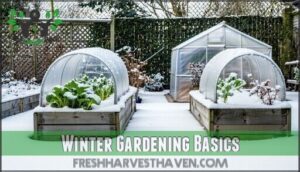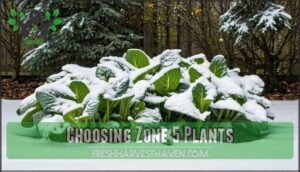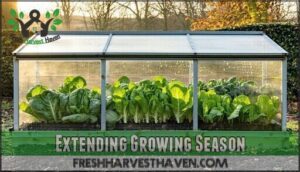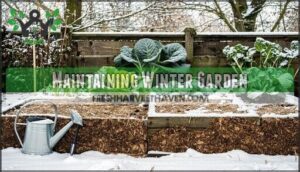This site is supported by our readers. We may earn a commission, at no cost to you, if you purchase through links.
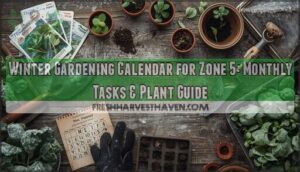 Your winter gardening calendar for zone 5 starts in January with indoor seed starting and continues through May’s final frost preparations.
Your winter gardening calendar for zone 5 starts in January with indoor seed starting and continues through May’s final frost preparations.
You’ll sow cool-season crops like lettuce, spinach, and peas in early spring while protecting tender plants with row covers and cold frames.
January through February focus on planning and starting hardy vegetables indoors, while March brings outdoor planting of cold-tolerant crops.
April’s your busy month for succession planting and transplanting seedlings, with May reserved for warm-season crop preparation.
The key is timing your plantings around zone 5’s average last frost date of mid to late April, which helps make your winter months become productive growing opportunities rather than dormant waiting periods, allowing for warm-season crop preparation and utilizing row covers and cold frames.
Table Of Contents
- Key Takeaways
- Winter Gardening Basics
- Choosing Zone 5 Plants
- Winter Gardening Calendar
- Extending Growing Season
- Maintaining Winter Garden
- Frequently Asked Questions (FAQs)
- . Why Should You Start Seeds indoors?
- . Which Seeds Should You Start indoors?
- . When Should You Start Seeds indoors?
- . When Should You Transplant seedlings?
- What is the last frost date for zone 5b?
- What month do you start a winter garden?
- What is cold hardy to USDA Zone 5?
- When to start fall garden zone 5?
- What is Zone 5 planting schedule?
- Is Your Zone 5 garden ready for winter?
- Conclusion
Key Takeaways
- Start indoor seed preparations in January and February – You’ll begin your zone 5 winter gardening by starting hardy vegetables like onions and leeks indoors, while planning your spring garden layout and maintaining tools during the coldest months.
- Plant cool-season crops strategically around frost dates – You’ll direct sow peas, spinach, and lettuce in early spring, timing your plantings around zone 5’s average last frost date of mid to late April for maximum success.
- Use protection methods to extend your growing season – You’ll maximize productivity by installing row covers, cold frames, and covering tunnels that can effectively move you up two USDA zones and provide 6-10°F of frost protection.
- Maintain consistent care through proper watering and mulching – You’ll keep your winter garden thriving by watering only when temperatures exceed 40°F, applying 2-3 inches of mulch for insulation, and harvesting root crops after frost for enhanced sweetness.
Winter Gardening Basics
Winter gardening in Zone 5 doesn’t mean your gardening season has to end when the first frost hits in mid-October.
With proper planning and the right techniques, you can keep harvesting fresh vegetables through the coldest months and give your garden a head start for spring.
Zone 5 Climate Considerations
Understanding zone 5 climate considerations is essential for successful winter gardening.
Frost dates typically span May 15th to October 15th, creating a 150-180 day growing season.
Temperature fluctuations can plunge to -20°F, while snowfall effects and hardiness zones determine plant survival.
Smart gardeners leverage microclimate impact – sunny spots and windbreaks – to extend their winter garden calendar and maximize zone 5 gardening success.
Winter Gardening Benefits
Zone 5 gardening doesn’t pause when winter arrives—it evolves into something remarkable.
Winter gardening benefits your garden and your table in ways you mightn’t expect. You’ll discover that pest reduction becomes your ally, as cold weather naturally controls harmful insects.
Your soil enrichment continues through strategic winter planning and organic matter decomposition. The year-round harvest keeps fresh vegetables flowing to your kitchen, while early blooms reward your patience come spring.
Winter vegetable gardens extend your growing season far beyond summer’s end. One key is to remember to implement sufficient frost protection for vulnerable plants.
Here’s what makes zone 5 winter gardening worth embracing:
- Extends season for continuous fresh produce
- Pest reduction eliminates summer’s biggest headaches
- Soil enrichment happens naturally through winter composting
- Early blooms give you a head start on spring neighbors
Preparing Garden for Winter
Once you’ve enjoyed those winter gardening benefits, it’s time to prep your zone 5 garden for the cold months ahead.
Start debris removal early, clearing diseased plants and fallen leaves that invite pests. Apply soil insulation through mulching—2-3 inches works perfectly for winter garden maintenance.
Consider various mulch options to protect your plants. Master pruning techniques on dormant trees and shrubs while they’re resting.
Shield vulnerable plants with burlap or covers for plant protection. Don’t forget spring planning: plant bulbs now or stratify seeds for gorgeous blooms.
Smart winter garden preparation makes zone 5 gardening and winter gardening much more rewarding come springtime!
Choosing Zone 5 Plants
You’ll want to choose plants that can handle Zone 5’s harsh winters, where temperatures drop to -20°F and the growing season runs about 150-180 days.
Smart plant selection means picking winter-hardy varieties like hostas and boxwoods, cool-season crops such as kale and spinach, and reliable perennials that’ll come back year after year, which is a key factor in reliable gardening in this zone.
Winter-Hardy Plant Selection
Once you’ve prepared your garden for winter, selecting the right plants becomes your next winning move. Think of winterhardy plants as your garden’s winter warriors—they’ll stand strong when temperatures plummet to -20°F and still greet you with beauty come spring.
Your plant lineup should include a mix of Evergreen Choices like boxwoods and junipers for year-round structure, plus Hardy Shrubs such as hydrangeas that’ll bounce back after harsh freezes. Ornamental Grasses add texture and movement, while Cold-Tolerant Varieties like hostas prove that zone 5 gardening doesn’t mean sacrificing beauty.
To succeed, it’s important to understand Zone 5 climate characteristics, including its cold winters and warm summers. Selecting plants requires understanding your hardiness zone to guarantee survival.
Here’s your winning plant selection strategy:
- Choose native winterhardy plants like birches and maples that naturally thrive in your climate
- Add evergreen backbone plants such as yew and holly for winter color and structure
- Include proven perennials like echinacea and sedums that survive freeze-thaw cycles
- Plant hardy winter vegetables and Fruit Trees for productive cold climate crops year-round
Cool-Season Crops for Zone 5
Cool-season crops transform your zone 5 gardening game with remarkable frost tolerance. These hardy winter vegetables laugh at light frosts and actually improve in flavor after cold snaps.
Winter vegetables actually get sweeter after freezing temperatures hit—nature’s way of rewarding patient gardeners.
- Leafy greens like spinach, kale, and Swiss chard survive temperatures down to 20°F
- Root vegetables including carrots, beets, and turnips store beautifully through winter
- Brassicas such as broccoli, cabbage, and Brussels sprouts thrive in cool conditions
Plan your planting schedule for late summer success and valuable harvesting tips.
Perennial Plants for Zone 5
Winter-hardy perennials form the backbone of your zone 5 garden, weathering harsh conditions with grace. You’ll find reliable performers like hostas, coneflowers, and hellebores that handle winter dormancy beautifully while promising spectacular spring bloom displays.
For perennial selection success, choose varieties rated for plant hardiness zone 5 or colder. Proper winter garden planning includes mulching these gems heavily to protect roots and maintain soil health.
When establishing perennial plants, focus on pest control early and amend your soil generously. Your zone 5 planting guide should include rhubarb and asparagus for edible options that’ll reward you for years to come.
Winter Gardening Calendar
Your Zone 5 winter gardening calendar helps you stay organized and productive throughout the colder months. By following monthly tasks, you’ll maintain your garden’s health and prepare for spring’s growing season.
January and February Tasks
Planning your winter gardening calendar for Zone 5 starts with January and February’s vital groundwork. These months offer prime time for garden planning while protecting dormant plants from harsh conditions.
Indoor seed starting for onions and leeks begins late January, while dormant pruning of fruit trees maximizes spring growth. Seed stratification for hardy perennials happens naturally outdoors now.
- Tool maintenance: Sharpen and sanitize pruners to prevent disease spread
- Houseplant care: Clean leaves and repot as needed for healthier growth
- Snow management: Brush heavy snow off branches to prevent breakage
Your zone 5 planting schedule depends on these winter preparations setting the stage for spring success.
March and April Tasks
March marks the turning point when Zone 5 gardeners can finally roll up their sleeves and get serious about starting seedlings indoors. Begin indoor seed starting for tomatoes and peppers around mid-March, giving them 6-8 weeks to develop before transplanting outdoors.
Cool-season crops like broccoli and lettuce should already be growing under lights by early March. Pruning techniques become essential as you tackle dormant fruit trees before bud break.
April brings the excitement of direct sowing hardy crops like peas and spinach once soil thaws. Pest control starts with cleaning up debris, while transplanting seedlings of cole crops can begin by late April when soil warms.
May Gardening Tasks
As May arrives, your zone 5 garden finally shakes off winter’s grip.
It’s time for transplanting seedlings like tomatoes and peppers outdoors, but remember to harden them off first. Direct sowing of warm-season crops can begin, and don’t forget essential garden cleanup tasks.
Consider planting by moon phases for maximum growth.
- Transplanting Seedlings: Move tender plants outside after hardening off, adding supports for tomatoes
- Sowing Seeds: Plant beans, squash, and corn directly in warmed soil
- Pest Control: Monitor for cucumber beetles and apply floating row covers for protection
Extending Growing Season
You can stretch Zone 5’s growing season well beyond the typical 150-180 days with some simple techniques.
Starting seeds indoors, using protective covers, and creating warm microclimates will keep your garden productive even when Jack Frost comes knocking.
Starting Seedlings Indoors
Before perfecting your transplant timing tips, you’ll want to master the art of starting seedlings indoors. This head start maximizes Zone 5’s short growing season by giving plants extra weeks to mature.
Use quality seed starting mix in drainage-equipped trays for superior results. Your indoor lighting setup should provide 12-16 hours of daily light, while germination temperature control maintains steady 70°F conditions using heating mats.
Many gardeners find success with winter sowing methods for cold-hardy plants.
| Timing | Plant Types | Key Action |
|---|---|---|
| 6-8 weeks before last frost | Tomatoes, peppers, eggplant | Start indoors |
| 4-6 weeks before last frost | Broccoli, cabbage, lettuce | Begin germination |
| 2-3 weeks before last frost | Start hardening off process | Gradual outdoor exposure |
Following your winter gardening calendar guarantees perfect transplant timing tips. The hardening off process involves gradual outdoor exposure for one week, preventing transplant shock.
Label everything and keep watering supplies handy—organization makes starting seedlings indoors much easier for your zone 5 garden calendar!
Using Row Covers and Cold Frames
Once you’ve got your seedlings started, you’ll want to protect them outdoors with row covers and cold frames. These season extension techniques are your best friends for zone 5 winter gardening.
Row Cover Types range from lightweight fabric offering 2-3°F protection to heavyweight materials providing 6-10°F of frost defense. Cold Frame Design creates mini-greenhouses that can boost temperatures by significant margins, perfect for temperature regulation. They can also exclude insect pests, safeguarding your crops.
Here’s what makes these tools so effective:
- Pest protection – they block insects while allowing sunlight through
- Moisture retention reduces watering needs
- Wind protection prevents plant desiccation
- Extended harvest periods for cold-hardy greens
- Earlier spring planting opportunities
Layer row covers inside cold frames for maximum protection – this combo can effectively move you up two USDA zones! Your winter gardening calendar becomes much more flexible when you’ve mastered these season extension methods.
Installing Covering Tunnels
Installing covering tunnels frequently transforms your winter gardening calendar for Zone 5 into a year-round adventure.
Build frames using PVC or metal hoops, then secure plastic or fabric coverings with sandbags or bricks for cold frames protection.
Tunnel Materials: Choose frost cloth or greenhouse plastic
Frame Construction: Use PVC arches or A-frames for stability
Securing Tunnels: Anchor edges properly against wind damage
Ventilation Needs: Open ends during mild days for air circulation
Remember snow removal from coverings prevents collapse, and proper installing covering tunnels techniques guarantee your zone 5 winter gardening success through harsh weather conditions.
Maintaining Winter Garden
Once your Zone 5 winter garden is established, you’ll need to maintain it through the cold months with proper watering and mulching techniques.
Smart harvesting and storage methods will keep your winter crops fresh and productive until spring arrives.
Watering and Mulching Strategies
After setting up season-extending structures, proper watering and mulching become your winter garden’s lifeline.
Water only when temperatures climb above 40°F, preferably in morning hours to prevent nighttime freezing damage.
Soil moisture management requires checking soil before watering – stick your finger two inches deep to test dryness.
For more accurate readings, consider using a Soil Moisture Meter to guarantee the best watering conditions.
Mulch types offer different benefits for your cold-season crops.
Here’s your winter gardening guide:
| Mulch Type | Best For | Insulation Rating | Cost |
|---|---|---|---|
| Straw | Vegetables | Excellent | Low |
| Wood Chips | Trees/Shrubs | Good | Medium |
| Leaves | Perennials | Fair | Free |
| Pine Needles | Acid-loving plants | Good | Low |
| Burlap | Tender plants | Excellent | Medium |
Apply 2-3 inches of mulch around plants for frost protection and winter insulation.
This water conservation technique reduces watering needs by 50%.
Skip watering leaves directly – wet foliage invites winter damage.
These watering strategies and mulching methods keep your garden thriving through Zone 5’s harsh conditions.
Harvesting and Storage Tips
Smart winter harvesting and root storage techniques maximize your Zone 5 garden’s productivity year-round.
Root crops like carrots and parsnips develop sweeter flavors after frost, while leafy greens can be harvested continuously under frost protection.
Store potatoes and beets in cool, dark spaces at 32-40°F with proper ventilation.
Fruit preservation through freezing and canning extends your harvest well into spring.
Practice crop rotation to maintain soil health, and collect seeds from hardy cold-season crops for seed stratification.
Regular storage checks prevent spoilage and keep your winter gardening efforts thriving through Zone 5’s challenging climate.
Frequently Asked Questions (FAQs)
. Why Should You Start Seeds indoors?
Starting seeds indoors gives you a head start on Zone 5’s short growing season.
You’ll extend your harvest window by 6-8 weeks, ensuring crops like tomatoes and peppers mature before October’s first frost hits your garden.
. Which Seeds Should You Start indoors?
Nearly 40% of Zone 5 gardeners start seeds indoors to extend their growing season.
You’ll want to start tomatoes, peppers, and eggplant indoors since they need warm soil and long growing periods to mature before fall frost arrives.
. When Should You Start Seeds indoors?
You’ll want to start most seeds indoors about 6-8 weeks before your last frost date, which typically falls around May 15th in Zone 5.
This timing gives seedlings enough time to develop strong roots and sturdy stems before transplanting outdoors.
. When Should You Transplant seedlings?
You should transplant seedlings outdoors after the last frost date, typically around May 15th in Zone Harden them off gradually during late April’s second or third week for best results.
What is the last frost date for zone 5b?
The last frost date for zone 5b typically falls between May 10-15, with May 15th being the most common benchmark.
You’ll want to monitor local weather conditions since this date can vary by a week or two depending on your specific location and annual weather patterns.
What month do you start a winter garden?
You’ll start your winter garden in late summer, typically by August 1st. This timing allows cold-hardy crops like spinach, kale, and carrots to mature before harsh winter weather arrives.
What is cold hardy to USDA Zone 5?
Don’t count your chickens before they hatch – you’ll need plants that can survive -15°F winters.
Zone 5 cold-hardy options include hostas, golden barberry, boxwoods, junipers, ornamental grasses, and hydrangeas for reliable winter survival.
When to start fall garden zone 5?
Plan your fall garden during mid-to-late July in Zone You’ll need to plant most winter crops by August 1st to guarantee they mature before the first frost around October 15th.
What is Zone 5 planting schedule?
You’ll find spring planting starts around May 15th after frost risk passes, while fall crops need seeding by August 1st for winter harvests before October’s first freeze.
Is Your Zone 5 garden ready for winter?
Your Zone 5 garden needs mulch, pruning, and protection to survive winter’s harsh temperatures. Check that you’ve cleaned debris, wrapped vulnerable plants, and applied insulation before the first hard freeze arrives.
Conclusion
Have you ever wondered how much food you can grow during the coldest months?
Your winter gardening calendar for zone 5 transforms harsh winter conditions into productive growing opportunities.
By following monthly tasks from January’s indoor seed starting through May’s warm-season preparations, you’ll maximize your harvest year-round.
Strategic use of row covers, cold frames, and proper timing around the mid-to-late April frost date guarantees continuous fresh produce.
Start planning now—your future self will thank you for those fresh winter greens!

